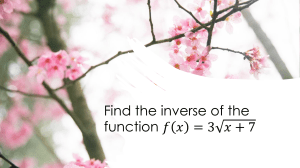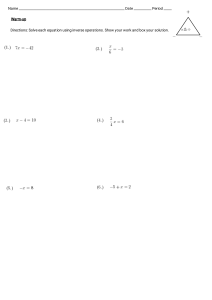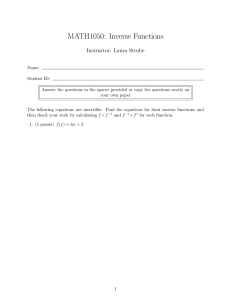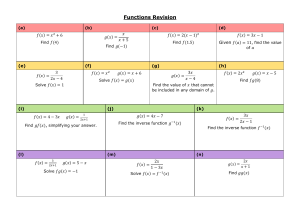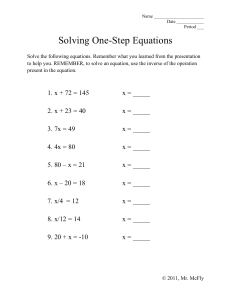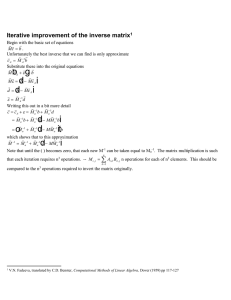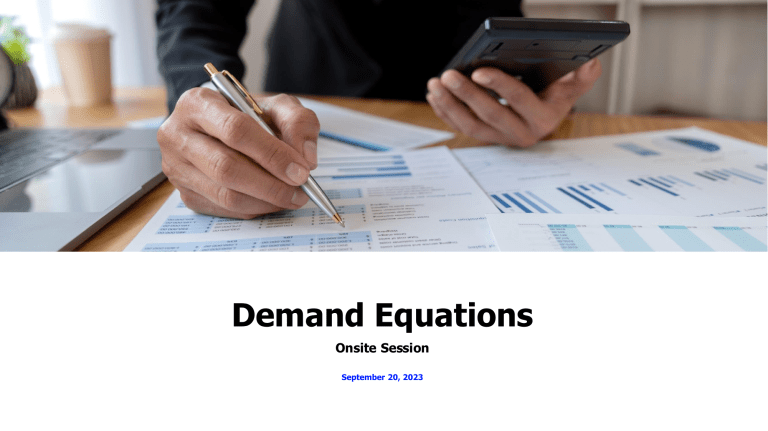
Demand Equations Onsite Session September 20, 2023 Three types of demand relations 2 1 General Demand Function 2 Direct Demand Functions Qd = f(P) 1 Inverse Demand Functions P = f(Qd) An LSEG Business • Qd = f ( P, M , PR , , Pe , N ) 1 General Demand Function Six variables that influence Qd • • • • • • Price of a good or service (P) Incomes of consumers (M) Prices of related goods & services (PR) Taste patters of consumers (T) Expected future price of a produce (Pe) Number of consumers in market (N) • 3 Qd = f ( P, M , PR , , Pe , N ) An LSEG Business General Demand Function Qd = a + bP + cM + dPR + e + fPe + gN Slope parameters are b, c, d, e, f, and g. Measure effect on Qd of changing one of the variables while holding the others constant Sign of parameter shows how variable is related to Qd • Positive sign indicates direct relationship • Negative sign indicates inverse relationship 4 An LSEG Business General Demand Function Qd = a + bP + cM + dPR + e + fPe + gN 5 An LSEG Business Direct Demand Function 2 The direct demand function, or simply demand, shows how quantity demanded, Qd , is related to product price, P, when all other variables are held constant. Law of Demand Qd increases when P falls & Qd decreases when P rises, all else constant ∆𝑄𝑑 ∆𝑃 must be negative Qd = f(P) 6 An LSEG Business Direct Demand Function A direct demand function is obtained by holding all the variables in the general demand function constant except price. For example, using a three-variable demand function, where the bar over the variables M and P means that those variables are held constant. ഥ 𝑷𝒓 = 𝒇(𝑷) 𝑸𝒅 = 𝒇 𝑷, 𝑴, 7 An LSEG Business 3 Inverse Demand Function Traditionally, price (P) is plotted on the vertical axis & quantity demanded (Qd) is plotted on the horizontal axis The equation plotted is the inverse demand function. P= f(Qd) 8 An LSEG Business THREE DEMAND SCHEDULES 𝑄𝑑 = 3,200 − 10𝑃 + 0.05𝑀 − 24𝑃𝑅 9 M = $60,000; PR=$200 M = $64,000; PR=$200 M = $52,000; PR=$200 𝑄𝑑 = 1,400 − 10𝑃 𝑄𝑑 = 1,600 − 10𝑃 𝑄𝑑 = 1,000 − 10𝑃 An LSEG Business THREE DEMAND SCHEDULES 𝑄𝑑 = 3,200 − 10𝑃 + 0.05𝑀 − 24𝑃𝑅 Demand Equations 10 An LSEG Business D0: Qd = 1400 - 10P Price M = $60,000; PR=$200 $140 $120 $100 $80 $60 $40 $20 0 200 400 600 800 1000 1200 D1: Qd = 1600 - 10P D2: Qd = 1000 - 10P M = $64,000; PR=$200 M = $52,000; PR=$200 200 400 600 800 1000 1200 1400 0 0 0 200 400 600 800 THREE DEMAND SCHEDULES Demand Equations 11 D0: Qd = 1400 - 10P D1: Qd = 1600 - 10P D2: Qd = 1000 - 10P Price M = $60,000; PR=$200 M = $64,000; PR=$200 M = $52,000; PR=$200 $140 0 200 0 $120 200 400 0 $100 400 600 0 $80 600 800 200 $60 800 1000 400 $40 1000 1200 600 $20 1200 1400 800 An LSEG Business DEMAND EQUATIONS – LEARNING BY DOING! Consider the general demand function: 𝑄𝑑 = 8,000 − 16𝑃 + 0.5𝑀 − 20𝑃𝑅 a. b. c. d. e. 12 Derive the equation for the demand function when M = $30,000 and PR=$50 Interpret the intercept and slope parameters of the demand function derived in part a. Sketch a graph of the demand function in part a. Where does the demand function intersect the quantitydemanded axis? Where does it intersect the price axis? Using the demand function from part a, calculate the quantity demanded when the price of the good is $1,000 and when the price is $500. Derive the inverse of the demand function in part a. Using the inverse demand function, calculate the demand price for 15,000 units of the good. An LSEG Business THANK YOU!
